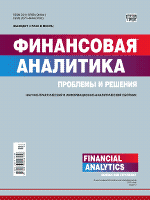Abstracting and IndexingРИНЦReferativny Zhurnal VINITI RAS Worldcat Google Scholar Online availableEastvieweLIBRARY.RU Biblioclub |
Analysis of the level of profitability and risk of income as per tax on natural resources production from oil extraction in regions of the Russian Federation
Available online: 1 September 2014 Subject Heading: Taxes and taxation JEL Classification: Pages: 32-42
Due to the resource-based economy in Russia, even the minor changes of oil prices on the international market have a tremendous impact on the State budget of the Russian Federation, and the issue of its replenishment recently acquired special urgency. Tax on natural resources production is one of the leading taxes of the Russian tax system. The article identifies the administrative draw-backs in the tax on natural resources production of the Russian Federation and proposes the ways of its improvement in current conditions. Using the statistical methods, the authors examine the trends of the returns of tax on natural resources production from the oil producing regions of the Russian Federation and define risk-return ratio of tax on natural resources production, as well as perform the clustering of regions. The paper offers a method of determining the actual tax burden on the basis of deflating of adjusted tax units that allows eliminating the inflationary tax component. The authors perform the clustering of the Russian regions in terms of the tax base and the amount of an adjusted tax on natural resources production revenues and propose the BCG matrix application to determine the positions of the various oil producing regions. The article makes an assessment of the risk-return ratio of income as per tax on natural resources production based on the coefficient of variation, which is calculated taking into account the share of regions in oil production and the Sharpe ratio and arrives at conclusions on the quality of the Russian Federation tax policy in an area of tax on natural resources production. Currently, there is growth in the actual load on the tax on natural resources production, while the real tax burden has a tendency to decrease. The reduction of an effective yield is accompanied by an increase of the tax risk. It is evidence that the quality of tax administration of tax on natural resources production worsens and it is mitigated by offset of inflationary component of tax: the rise in world prices and political decisions to increase the basic rate of tax. Keywords: tax on natural resources production, tax revenues, tax burden level, tax base, modeling, correlation, region clustering References:
|
ISSN 2311-8768 (Online)
|
|








